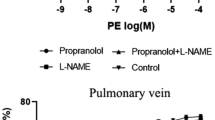Summary
In bioassay and organ bath experiments, the responses of different canine venous preparations to arterial and their own EDRF were studied. Vena jugularis, vena femoralis and vena mesenterica relaxed on both EDRFs released by acetylcholine. Vena saphena, venae cordis and vena portae did not showendothelium-dependent dilation, either under bioassay or in organ bath experiments. All the veins tested relaxed completely after sodium nitroprusside administration. The identity of EDRF and nitric oxide is not confirmed by this study.
Similar content being viewed by others
References
Bergner M, Gräser T, Handschuk L, Tiedt N (1988) The action of acetylcholine, norepinephrine and histamine on isolated porcine coronary veins. Biomed Biochim Acta: in press
Feletou M (1987) Arteries, veins and endothelium-dependent relaxation: cellular effects. Thromb Res, Suppl VII:4
Förstermann U (1986) Properties and mechanisms of production and action of endothelium-derived relaxing factor. J Cardiovasc Pharmacol 8, Suppl 10:S45-S51
Furchgott RF (1983) Role of endothelium in responses of vascular smooth muscle. Circ Res 53:557–573
Furchgott RF, Khan MT, Jothianandan D (1987) Evidence supporting the proposal that endothelium-derived relaxing factor is nitric oxide. Thromb Res, Suppl VII:5
Furchgott RF, Zawadzki JV (1980) The obligatory role of endothelial cells in the relaxation of arterial smooth muscle by acetylcholine. Nature 288:373–376
Gräser T, Vedernikov YP, Tiedt N (1987) Unterschiede in der Azetylcholinwirkung an isolierten Koronararterien und-venen des Hundes. Rolle des Gefäßendothels. Ergebn Exp Med 48:141–151
Manderson JA, Campbell GR (1986) Venous response to endothelial denudation. Pathology 18:77–88
Palmer RMJ, Ferrige AG, Moncada S (1987) Nitric oxide release accounts for the biological activity of endothelium-derived relaxing factor. Nature 327:524–526
Sharov VG, Vedernikov YP, Anikin AA, Vikhert AM (1986) Rapid method of visualizing endothelium in unfixed tissue. Bull Exper Biol Med 102:1613–1615
Shikano K, Berkowitz BA (1987) Endothelium-derived relaxing factor is a selective relaxant of vascular smooth muscle. Fed Proc 46:386
Vanhoutte PM, Miller VM (1985) Heterogeneity of endothelium-dependent responses in mammalian blood vessels. J Cardiovasc Pharmacol 7, Suppl 3:S12-S23
Vanhoutte PM, Rubanyi GM, Miller VM, Houston DS (1986) Modulation of vascular smooth muscle contraction by the endothelium. Ann Rev Physiol 48:307–320
Vedernikov YP, Gräser T, Osis Y (1988) Endothelium-derived relaxing factor as a local modulator of arterial function. Possibility of stabilization. Setchenoff Physiol J 74:153–161
Vedernikov YP, Gräser T, Tiedt N (1987) Is there an abluminal release of endothelium-derived relaxing factor (EDRF)? Basic Res Cardiol 82:172–177
Vedernikov YP, Vikhert AM, Leisner H (1987) Arterial endothelium-derived relaxing factor (AEDRF) does not suppress papillary muscle or portal vein contractions. Eur J Pharmacol 142:471–474
Author information
Authors and Affiliations
Rights and permissions
About this article
Cite this article
Vedernikov, Y.P., Gräser, T., Tiedt, N. et al. Heterogeneity of the response of venous smooth muscle to arterial endothelium-derived relaxing factor (EDRF) in respect of the role of nitric oxide. Basic Res Cardiol 83, 122–127 (1988). https://doi.org/10.1007/BF01907265
Received:
Issue Date:
DOI: https://doi.org/10.1007/BF01907265




